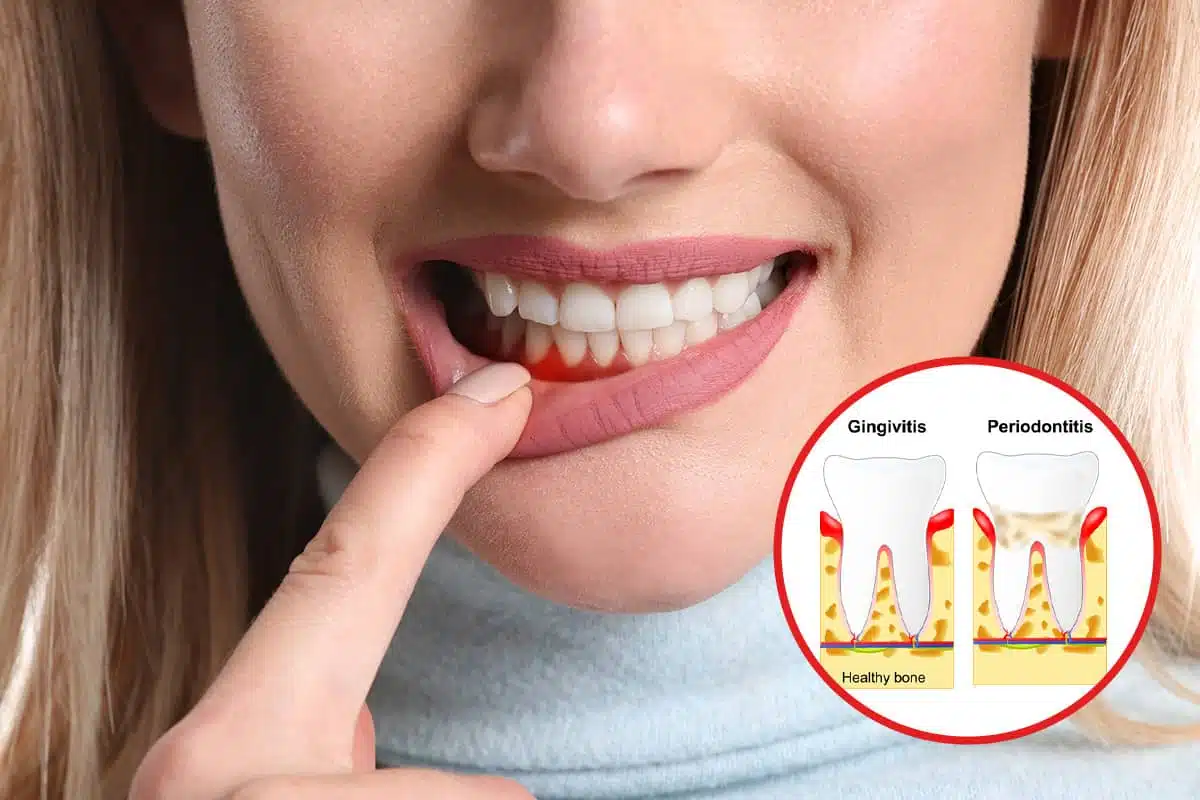
Have you ever noticed your gums bleeding while brushing or flossing? While it might seem minor, this could be your body’s early warning sign of gum disease. Understanding the difference between gingivitis and periodontitis is the first step in protecting your smile.
Both conditions are forms of gum disease, but they aren’t created equal. Gingivitis is where it starts—but left unchecked, it can evolve into periodontitis, a far more serious and potentially irreversible problem. Keep reading to learn how to spot the signs early and what to do next.
Which is Worse, Gingivitis or Periodontitis?
Gingivitis is considered the earliest and mildest stage of gum disease, and the good news is that it’s reversible with proper care. Periodontitis, on the other hand, is a more severe condition that can lead to gum recession, bone loss, and even tooth loss if left untreated.
Because gingivitis can be halted and reversed, it’s considered the less severe of the two. But without prompt attention, it can progress—making early intervention essential. Let’s break down how these two conditions differ and what you should watch for.
Definition and Main Differences
What is Gingivitis?
Gingivitis is the earliest and mildest stage of gum disease, marked by inflammation of the gum tissue caused by plaque buildup along the gumline. At this stage, the condition is typically painless and reversible with proper oral hygiene. Common signs include redness, swelling, and bleeding gums—especially during brushing or flossing.
What is Periodontitis?
Periodontitis is an advanced form of gum disease that occurs when gingivitis goes untreated. It affects not only the gums but also the deeper supporting structures like bone and connective tissue. As the infection progresses, it can lead to gum recession, the formation of deep pockets, loose teeth, and even tooth loss without professional intervention.
Signs and Symptoms
Symptoms of Gingivitis
Gingivitis often develops quietly, with symptoms that can be subtle or easily overlooked. The most common signs include red, puffy gums and bleeding during brushing or flossing. Gums may also feel tender to the touch, and persistent bad breath can be a clue that gum inflammation is present, even in the absence of pain.
Symptoms of Periodontitis
As periodontitis progresses, symptoms become more pronounced and serious. Gums may recede, exposing more of the teeth, and pockets can form between the gums and teeth. These pockets trap bacteria, leading to infection and further inflammation. Over time, teeth may become loose or shift position, and chewing can become painful or uncomfortable.

Causes and Risk Factors
Causes of Gingivitis
The primary cause of gingivitis is the accumulation of plaque—a sticky film of bacteria that forms on teeth when sugars and starches interact with oral bacteria.
Poor oral hygiene allows this plaque to build up, irritating the gums and leading to inflammation. Additional contributors include hormonal changes, such as those during pregnancy or puberty, and certain medications that reduce saliva flow.
Causes of Periodontitis
Periodontitis typically develops when gingivitis is left untreated. Over time, plaque hardens into tartar, which harbors bacteria that penetrate deeper into the gums.
This triggers an immune response that begins to break down the bone and connective tissue supporting the teeth. Risk factors include smoking, diabetes, genetics, a diet high in refined carbs, and immune-compromising conditions like HIV or AIDS.
Treatment and Reversibility
Treatment for Gingivitis
Treating gingivitis starts with improving daily oral hygiene practices. Brushing twice a day, flossing regularly, and using an antiseptic mouthwash can significantly reduce plaque buildup and gum inflammation. In many cases, professional dental cleaning is necessary to remove hardened tartar and fully restore gum health. With consistency, symptoms often resolve within a few weeks.
Treatment for Periodontitis
Managing periodontitis usually requires more intensive care. Deep cleaning procedures like scaling and root planing help remove plaque from beneath the gumline. In advanced cases, localized antibiotics or surgical intervention may be needed to clean infected pockets and preserve the tooth structure. Periodontitis is not fully reversible, but with proper care, its progression can be halted and managed long-term.
Prevention and Oral Hygiene
Preventing both gingivitis and periodontitis begins with a strong commitment to daily oral care. Brushing at least twice a day—especially after meals—helps remove plaque before it hardens into tartar. Flossing is just as important, as it clears debris and bacteria from between teeth where a toothbrush can’t reach.
In addition to daily habits, regular dental checkups are essential. Routine cleanings allow your dentist to remove tartar and monitor for early signs of gum disease. Other preventive tips include quitting smoking, managing conditions like diabetes, eating a balanced diet low in refined sugars, and using mouthwash to reduce harmful bacteria.
Before & After Photos


* All patients are unique and individual results may vary.
Stages of Gum Disease
Gum disease develops gradually, beginning with mild symptoms and potentially progressing to more serious complications if left untreated. Understanding the stages can help individuals recognize where they stand and take appropriate action before more aggressive treatment becomes necessary.
Gingivitis (Stage 1)
This initial stage is marked by inflammation of the gums caused by plaque buildup along the gumline. Gums may appear red or swollen and bleed easily during brushing or flossing. At this point, there is no damage to bone or connective tissue, and the condition is entirely reversible with good oral hygiene.
Early Periodontitis (Stage 2)
If gingivitis is left untreated, it can develop into early periodontitis. In this stage, plaque begins to spread below the gumline, leading to the formation of gum pockets. These pockets allow bacteria to penetrate deeper, causing minor bone and tissue damage and the start of gum detachment from the teeth.
Moderate Periodontitis (Stage 3)
As the disease progresses, the damage becomes more extensive. Gum pockets deepen, and infection begins to affect more of the surrounding bone and connective tissue. Teeth may start to loosen or shift, and individuals often experience discomfort while chewing or increased sensitivity.
Advanced Periodontitis (Stage 4)
This is the most severe form of gum disease. At this stage, significant bone and tissue loss occurs, making teeth unstable or resulting in tooth loss altogether. Deep infections, severe gum recession, and the need for complex dental treatments—such as surgery or extractions—are common.
Choosing the Best Dentist for Your Gums
Gum disease can escalate quickly without the right care, which is why choosing an experienced dental professional is critical. A specialist in periodontics understands the progression of gum disease and can provide effective treatment tailored to each stage—ensuring your oral health doesn’t suffer long-term consequences.
With an unwavering dedication to the field of periodontics, Dr. John Paul Gallardo, DDS, PA, stands as South Florida’s leading periodontist and implant specialist. With over 25 years of experience, he’s known for meticulous care and techniques that provide life-long results. At Gallardo Periodontics and Implant Dentistry, we use advanced technologies and offer IV conscious sedation for maximum comfort. Ready to take control of your gum health? Call us at 305-447-1447 or visit our contact page to schedule your consultation today.